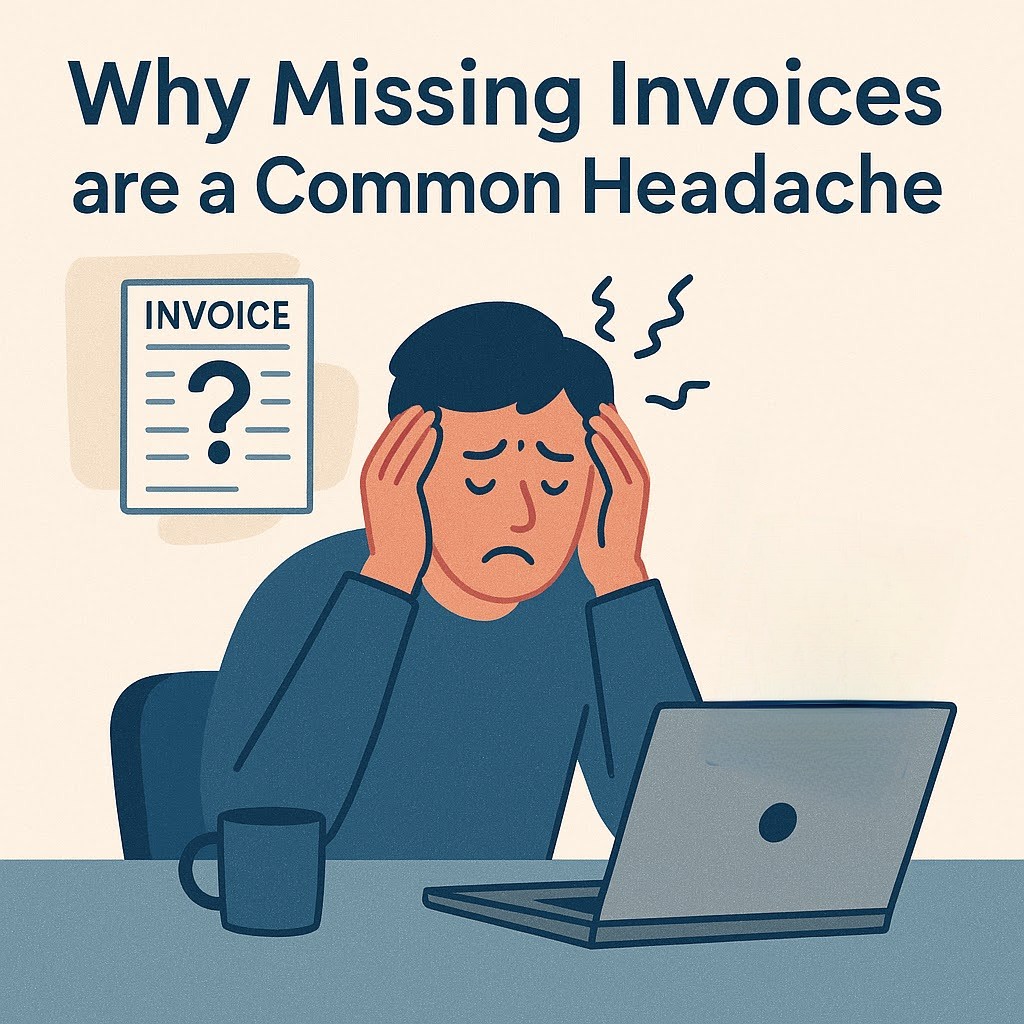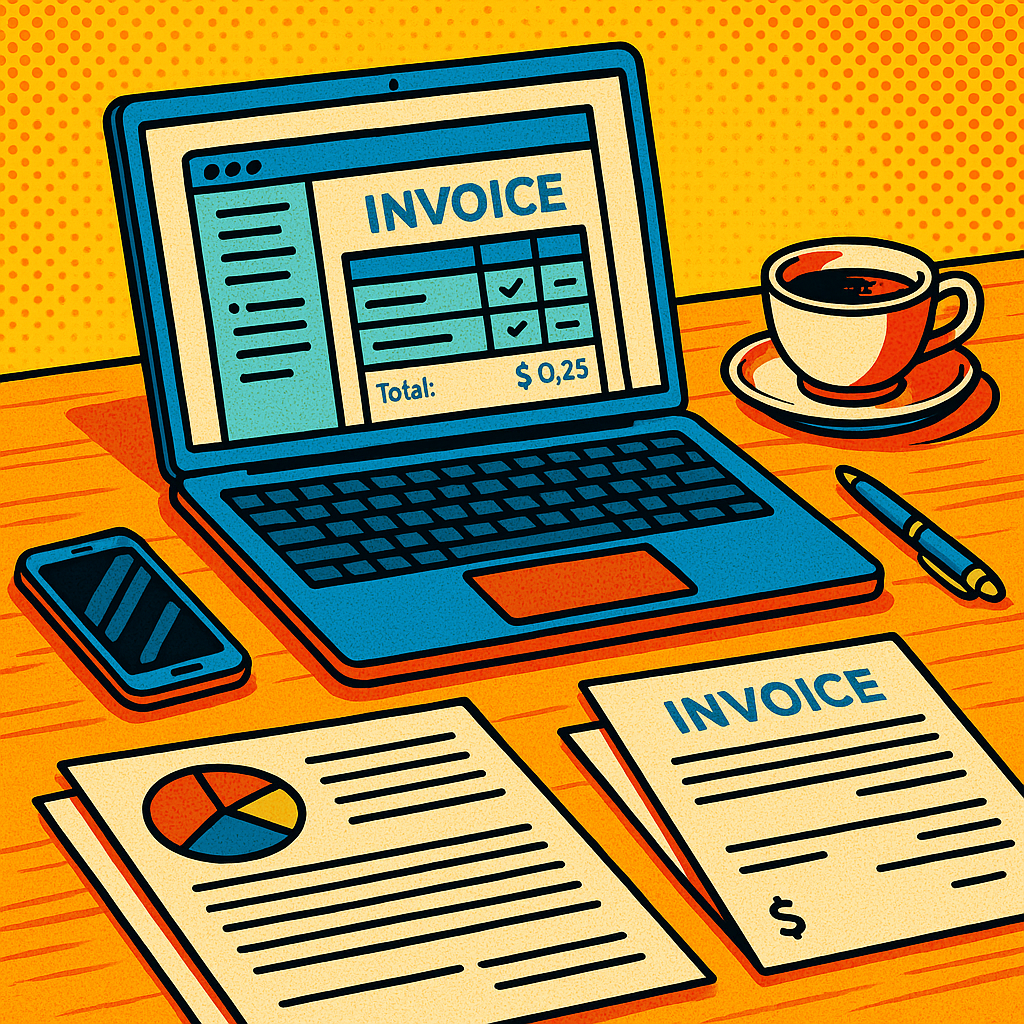Why Lost or Missing Invoices Still Haunt Small Businesses
Hey Jordan, quick reality check from last quarter: remember when our freight partner “misfiled” the March invoice and Accounts Payable found out only after the VAT deadline? We spent two afternoons digging through Outlook archives, Slack threads, and a dusty Dropbox folder named “misc-docs-old.” Sound familiar? It’s never the big ticket items that trip you up— it’s that one $1,147.32 freight charge that silently blows up your month-end close.

The Hidden Cost of a Single Misplaced PDF
On paper, a missing invoice looks trivial. In practice, it’s late-payment penalties, suspense accounts, and a finance team that can’t forecast cash flow with a straight face. I spoke to Jenna at BoltWorks last week; she had to re-issue twelve customer statements because one supplier’s invoice vanished in cyberspace. Twelve. By the time she located half the back-up emails, her team could have been chasing new revenue. We’ve both read checklists before, but this 9-step recovery plan really nails the order of operations—start with a rapid digital audit, then escalate to supplier outreach only if you’re truly stuck.
Meet InvoiceGenie—Your New Sidekick in Invoice Recovery
Enter InvoiceGenie. Instead of ping-ponging between your ERP, Gmail, and that “we’ll-organize-it-later” folder, you drop the few details you do have—supplier name, PO number, approximate date—into the app. Seconds later, you’ve got a compliant PDF stamped, numbered, and ready for approval. No smoke and mirrors, just a workflow we wish we’d built in-house years ago. If you’re skeptical, skim the fast & simple playbook their team posted; it walks through edge cases like partial receipts and currency mismatches.
Bottom line: running a lean business means treating missing invoices as the operational liabilities they are. Ignore them, and they metastasize; tackle them proactively, and your close process finally stops feeling like whack-a-mole.
Step-by-Step Plan to Locate, Recreate, and Prevent Lost Invoices
Last Friday, during our finance roundtable, Sam from AeroParts said something that stuck with me: “We’re great at shipping turbine blades across 12 time-zones, but we can’t keep a $600 tooling invoice alive for 30 days.” The room nodded—everybody’s been there. Below is the exact playbook I shared, distilled from nine implementations we ran this spring.
Phase 1 — Rapid Search & Audit (15 minutes max)
Start with metadata, not PDFs. Filter email by supplier domain and the PO number; then run a quick filename search in Google Drive. If you’re on Microsoft 365, the new Copilot plugin will surface documents by semantic context—huge time-saver. Pro tip: pop the findings into a heat-map spreadsheet; red cells flag gaps instantly.
Phase 2 — Recreate Instantly with InvoiceGenie
Still missing files? Open InvoiceGenie, select “Rebuild from PO,” and feed it the purchase data. The algorithm cross-checks your tax locale, auto-increments the invoice number, and spits out a compliant PDF in—yes—under five seconds. We trialed this at EcoLumens: 47 historical gaps resolved before lunch, which shaved four days off their year-end close.
Phase 3 — Validate for Tax & Compliance
Recreated docs aren’t useful unless they survive an audit. Cross-verify totals against the general ledger; then run a reverse-sales-tax check. If you’re unsure, bookmark the EU’s latest VAT thresholds—regulators tweaked them in January, and a few colleagues got burned for rounding errors.
Phase 4 — Automate Future Prevention
Finally, stop the bleeding. Enable auto-reminders in InvoiceGenie to ping suppliers five days pre-due-date. Layer on an RPA bot (UiPath or Power Automate) that archives every inbound PDF to a version-controlled repository. At SummitTech, this combo dropped “invoice hunt” tickets by 82 % in one quarter, freeing the AP team for vendor-discount negotiations instead of detective work.
Common Roadblocks & Real-World Pushback
Now, you might be thinking, “Cool story, but my supplier in Shenzhen hasn’t answered an email since Lunar New Year—how do I recreate that invoice?” Fair point. Even the slickest workflow breaks down if the data never existed in your inbox to begin with. In those cases, lean on whatever breadcrumbs you do have: shipping docs, wire confirmations, even WhatsApp screenshots of the agreed price. I once watched a controller at NeonArc stitch together a full audit trail from a customs declaration and a PayPal receipt. Was it pretty? Nope. Did it satisfy the external auditors? Surprisingly, yes, because she attached a signed management representation letter to document intent.
But here’s the thing—recreated PDFs still raise eyebrows if your internal controls are loose. Skeptical auditors love hunting for duplicate invoice numbers, so always lock your sequence generator once the file is issued. I learned this the hard way during a SOC 2 readiness review when two vendors, both named “GlobalTech,” collided in the numbering scheme. Thirty frantic minutes later, we adopted a supplier-prefix convention, and the issue vanished.
Security jitters are another sticking point. “Isn’t throwing financial data into any cloud app just begging for trouble?” Totally valid concern. The workaround? Zero-trust permissions. At PulseWave, we restricted InvoiceGenie access to a service account that pipes PDFs straight into the DMS; finance staff never see the raw data in the web UI. Add MFA and an hourly token rotation, and your CISO will sleep easier.
Finally, let’s talk human bandwidth. Automation sounds great until your overworked AP clerk has to babysit exceptions all day. If your team is buried in open items, bring in a freelance accountant for a month—seriously. A $3K engagement fee can recover $20K in early-payment discounts you’re currently forfeiting. Counter-intuitive, but the ROI checks out every time we model it.
Bringing It All Home
Remember that $1,147.32 freight charge we misplaced in March—the one that kicked off this whole conversation? It wasn’t just a bookkeeping nuisance; it was a mirror, showing us how fragile an otherwise “buttoned-up” operation can be. Over the last few paragraphs we mapped the search-audit-recreate loop, poked holes in the process where auditors, suppliers, or sheer human fatigue might derail us, and stress-tested the fixes against real companies with real deadlines. If nothing else, I hope it’s clear that a missing invoice isn’t an isolated glitch; it’s a signal flare announcing bigger systemic leaks—version-control gaps, unclear numbering schemes, or a reliance on inbox archaeology as a filing system.
So where does that leave us? Probably at the same crossroads every finance lead hits sooner or later: keep firefighting or engineer the fire-proofing. Maybe that means spinning up InvoiceGenie tomorrow morning, or maybe it’s as small as blocking thirty minutes to label every AP email that lands this week. Either way, the point isn’t the tool (helpful though it is); it’s the mindset shift from reactive recovery to proactive resilience. Cash flow, audit readiness, vendor relations—they all breathe easier when documentation is boringly predictable.
If you’re still skeptical, good—healthy doubt is the accountant’s superpower. Test the workflow on one stubborn invoice, measure how long it actually takes, then decide if the juice is worth the squeeze. Who knows, you might rediscover a few early-payment discounts hiding in plain sight—or at the very least earn back a Tuesday afternoon that would’ve been spent spelunking through “misc-docs-old.” And if a future you closes the books without that familiar end-of-month scramble? Well, jot down the feeling; it’s worth remembering the next time a PDF ghosts your inbox.
Frequently Asked Questions
1. How does “Lost or Missing Invoices: A 2024 Survival Guide for Entrepreneurs” differ from typical AP checklists?
Most checklists focus on compliance boxes; our guide layers in real-world anecdotes and a turnkey workflow that starts with the “Step-by-Step Plan to Locate, Recreate, and Prevent Lost Invoices,” so you’re not just ticking boxes—you’re reclaiming hours.
2. Can I really recreate supplier invoices without jeopardizing audit integrity?
Yes, provided you follow the validation tactics outlined in the “Common Roadblocks & Real-World Pushback” section—specifically, locking invoice sequencing and attaching evidence such as shipping docs or payment receipts.
3. What if my biggest hurdle is vendor non-responsiveness?
The article’s “Communication Templates” under the practical blueprint give you escalation scripts, and if you need more ammo, this extended playbook—14 Proven Fixes to Stop Cash Leaks—adds late-fee language that can nudge stubborn suppliers.
4. Is cloud-based invoice generation secure enough for sensitive industries?
We tackle this head-on in the “Security Concerns” subsection, highlighting zero-trust permissions, MFA, and hourly token rotation—all of which satisfy most SOC 2 and ISO 27001 frameworks.
5. What’s one quick win I can apply today from the guide?
Fire up the 15-minute Rapid Search & Audit routine detailed in the “Step-by-Step Plan.” Even if you uncover just one wayward PDF, you’ll validate the process and set the stage for broader automation tomorrow.

